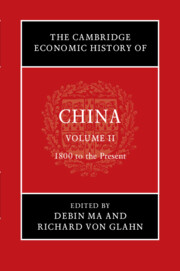Book contents
- The Cambridge Economic History of China
- The Cambridge Economic History of China
- The Cambridge Economic History of China
- Copyright page
- Contents
- Figures
- Maps
- Tables
- Contributors to Volume II
- Acknowledgments
- Note on Citations
- Introduction to Volume II
- Part I 1800–1950
- Part II 1950 to the Present
- Index
- References
Part II - 1950 to the Present
Published online by Cambridge University Press: 07 February 2022
- The Cambridge Economic History of China
- The Cambridge Economic History of China
- The Cambridge Economic History of China
- Copyright page
- Contents
- Figures
- Maps
- Tables
- Contributors to Volume II
- Acknowledgments
- Note on Citations
- Introduction to Volume II
- Part I 1800–1950
- Part II 1950 to the Present
- Index
- References
Summary

- Type
- Chapter
- Information
- The Cambridge Economic History of China , pp. 529 - 828Publisher: Cambridge University PressPrint publication year: 2022

